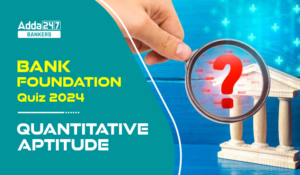
Q1. The difference between 20% of a number and 4/5th of same number is 2499. What is 2/7th of that number?
(a) 2156
(b) 1190
(c) 1090
(d) 1465
(e) None of these
Q2. Prithvi spent Rs. 89745 on his college fees, Rs. 51291 on personality development classes and the remaining 27% of the total amount he had as cash with him. What was the total amount?
(a) Rs. 185400
(b) Rs. 189600
(c) Rs. 191800
(d) Rs. 193200
(e) None of these
Q3. Vaishali spent Rs. 31897 on the air conditioner for the home, Rs. 38789 on buying plasma television and the remaining 23% of the total amount she had as cash with her. What was the total amount?
(a) Rs. 74625
(b) Rs. 86750
(c) Rs. 91800
(d) Cannot be determined
(e) None of the above
Q4. Beena spend Rs. 44668 on her air tickets, Rs. 56732 on buying gifts for the family members and the remaining 22% of the total amount she had as cash with her. What was the total amount?
(a) Rs. 286000
(b) Rs. 130000
(c) Rs. 101400
(d) Rs. 338000
(e) None of these
Q5. A sum of Rs. 731 is divided among A, B and C, such that A receive 25% more than B and B receives 25% less than C. What is C’s share in the amount?
(a) Rs. 172
(b) Rs. 200
(c) Rs. 262
(d) Rs. 258
(e) None of these
Q6. Mr Giridhar spends 50% of his monthly income on household items and out of the remaining, he spends 50% on transport, 25% on entertainment, 10% on sports and remaining amount of Rs. 900 is saved. What is Mr Giridhar’s monthly income?
(a) Rs. 6000
(b) Rs. 12000
(c) Rs. 9000
(d) Cannot be determined
(e) None of these
Q7. Mr X spends 20% of his monthly income on household expenditure. Out of the remaining 25% he spends on children’s education, 15% on transport, 15% on medicine and 10% on entertainment. He is left with Rs. 9800 after incurring all these expenditures. What is his monthly income?
(a) Rs. 35000
(b) Rs. 28000
(c) Rs. 65333
(d) Rs. 48400
(e) None of these
Q8. In a class of 35 students and 6 teachers, each student got sweets that are 20% of the total number of students and each teacher got sweets that are 40% of the total number of students. How many sweets were there?
(a) 245
(b) 161
(c) 406
(d) 84
(e) None of these
Q9. In a class of 80 students and 5 teachers, each student got sweets that are 15% of the total number of students and each teacher got sweets that are 25% of the total number of students. How many sweets were there?
(a) 1030
(b) 1040
(c) 1050
(d) 1060
(e) None of these
Q10. 405 sweets were distributed equally among children in such a way that the number of sweets received by each child is 20% of the total number of children. How many sweets did each child receive?
(a) 15
(b) 45
(c) 9
(d) 18
(e) None of these
Q11. A candidate appearing for an examination has to secure 35% marks to pass. But he secured only 40 marks and failed by 30 marks. What would be the maximum marks to test?
(a) 280
(b) 180
(c) 200
(d) 150
(e) 210
Q12. In an election between two candidates, one got 52% of total valid votes. 25% of the total votes were invalid. The total number of votes were 8400. How many valid votes did the other person get?
(a) 3276
(b) 3196
(c) 3024
(d) Cannot be determined
(e) None of these
Q13. The ratio of students in school A, B and C is 5 : 4 : 7 respectively. If number of students in schools are increased by 20%, 25% and 20% respectively, then what will be the ratio of students in school A, B and C respectively?
(a) 5 : 5 : 7
(b) 30 : 25 : 42
(c) 30 : 20 : 49
(d) Cannot be determined
(e) None of these
Q14. Population of a country increases every year by 10%. If the population in January 2006 was 15.8 lakh, what will be the population in January 2008?
(a) 19.11800
(b) 18.96000
(c) 19.11600
(d) 18.94000
(e) None of these
Q15. The price of rice decreases by 6.25% and because of this reduction, Vandana is able to buy 1 kg more for Rs. 120. Find the reduced rate of rice.
(a) Rs. 7.50 per kg
(b) Rs. 9 per kg
(c) Rs. 5.50 per kg
(d) Rs. 19 per kg
(e) Rs. 8 per kg




 Quantitative Aptitude Quiz For Bank Main...
Quantitative Aptitude Quiz For Bank Main...
 Quantitative Aptitude Quiz For Bank Foun...
Quantitative Aptitude Quiz For Bank Foun...





